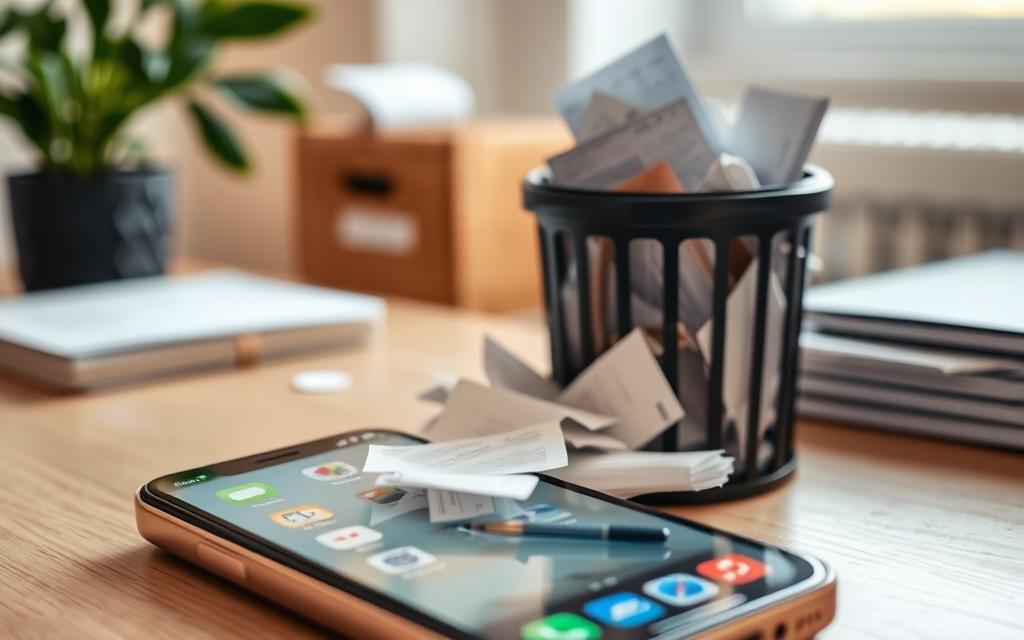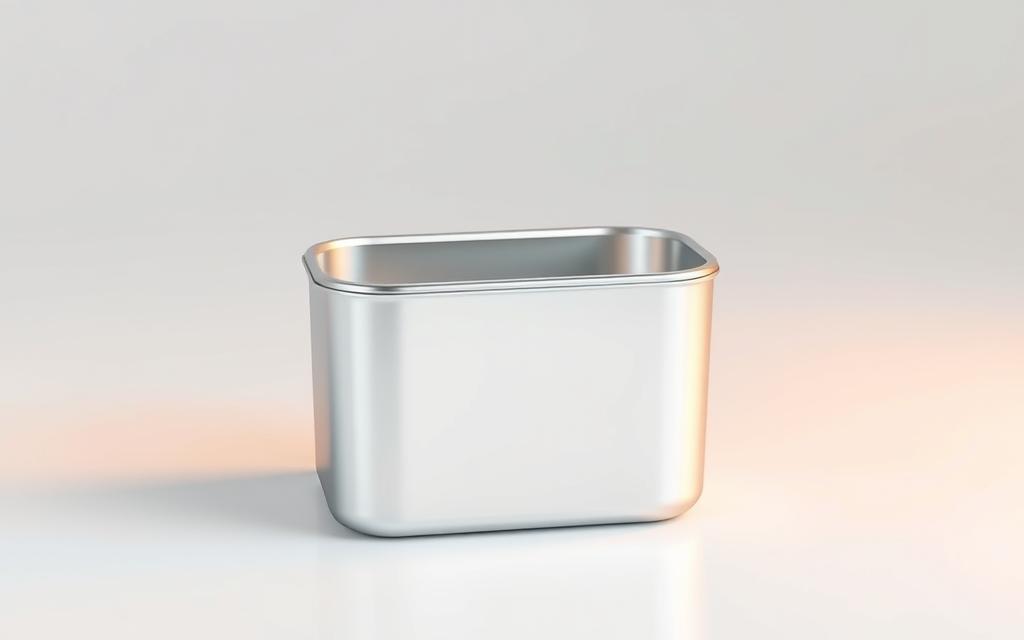Table of Contents
Managing storage space on your iPhone is essential for maintaining optimal performance. While there’s no traditional recycle bin, iOS uses app-specific folders like “Recently Deleted” to temporarily store removed files. These folders retain items for 30 days, allowing recovery if needed.
Key apps such as Files, Photos, Mail, and Notes follow this system. For immediate storage recovery, manual deletion from these folders is necessary. This process not only frees up space but also enhances your device’s efficiency.
Third-party tools like CleanMy®Phone can simplify photo management, ensuring your storage remains organized. Understanding these workflows helps you maintain a clutter-free iPhone and improve its overall performance.
Understanding the iPhone Recycle Bin
Unlike desktops, iPhones don’t have a centralized trash folder. Instead, iOS uses app-specific folders like “Recently Deleted” to temporarily store removed files. This system ensures deleted items remain recoverable for 30 days, offering a safety net for accidental deletions.
What is the iPhone Recycle Bin?
Individual apps such as Files, Photos, Mail, and Notes maintain their own “Recently Deleted” folders. These folders act as a recycle bin, holding items for a set period before permanent removal. For example, photos stay in the “Recently Deleted” album for 30 days, while messages might linger for up to 40 days.
This app-specific approach contrasts with desktop systems, where a single trash folder manages all deleted files. iOS’s method provides granular control, ensuring users can recover specific items without affecting others.
Why is it Important to Empty the Recycle Bin?
Deleted files still occupy storage space until they are permanently removed. For instance, a 22GB photo library can consume significant resources if not cleared. Regularly emptying these folders frees up space, improving device performance.
iOS also integrates security features like Face ID to protect access to “Recently Deleted” folders. This ensures sensitive files remain secure even after deletion. Native apps automatically purge items after the retention period, but manual removal offers immediate storage recovery.
| App | Retention Period | Storage Impact |
|---|---|---|
| Photos | 30 days | High |
| Files | 30 days | Moderate |
| 30 days | Low | |
| Notes | 30 days | Low |
Third-party tools like AnyTrans can streamline this process, but native iOS management remains efficient for most users. Understanding these workflows helps maintain a clutter-free device and optimizes system resources.
How to Empty the Recycle Bin on an iPhone Using the Files App
The Files app on your iPhone is a powerful tool for managing documents and freeing up storage. It allows you to access, organize, and permanently remove unwanted files. This app is particularly useful for handling items in the “Recently Deleted” folder, ensuring your device remains clutter-free.

Step 1: Open the Files App
To begin, locate and open files on your iPhone. You can access it directly from your home screen or use Spotlight Search for quick navigation. Once launched, the app displays all your stored documents and folders.
Step 2: Navigate to Recently Deleted
Next, tap recently deleted under the “Browse” tab. This folder contains all files removed within the last 30 days. Review the items carefully to ensure you don’t accidentally delete anything important.
Step 3: Select and Delete Files
To permanently remove files, tap “Select” in the upper right corner. Choose the items you want to delete, then tap delete. A confirmation prompt will appear, requiring a second tap to finalize the action. For bulk removal, use the “Delete All” option.
| File Type | Storage Impact | Retention Period |
|---|---|---|
| PDFs | Moderate | 30 days |
| Documents | Low | 30 days |
| App Exports | High | 30 days |
For advanced file management, tools like AnyTrans offer cross-device solutions. These tools are especially useful for users with large storage needs or those who frequently transfer files between devices.
Regularly clearing the “Recently Deleted” folder not only recovers storage but also enhances your iPhone’s performance. By following these steps, you can maintain an organized and efficient device.
Clearing Recently Deleted Items in Photos
Your iPhone’s photo library can quickly become cluttered with unnecessary images and videos. The Photos app provides a straightforward way to manage and permanently remove these files. By clearing the “Recently Deleted” album, you can free up valuable storage space and keep your device running smoothly.
Step 1: Open the Photos App
Start by launching the Photos app on your iPhone. This app organizes your media into albums, making it easy to locate and manage your files. The “Recently Deleted” album is where all removed photos and videos are temporarily stored.
Step 2: Access the Recently Deleted Album
Navigate to the “Albums” tab and scroll down to find the “Recently Deleted” folder. This album retains deleted items for 30 days, allowing you to recover them if needed. Accessing this folder may require Face ID authentication for added security.
Step 3: Permanently Delete Photos
To permanently remove files, tap “Select” and choose the items you want to delete. Confirm your selection by tapping “Delete All” or individually selecting files. This action immediately frees up storage space and prevents accidental recovery.
“Regularly clearing your photo library ensures your iPhone remains efficient and clutter-free.”
Third-party tools like CleanMy®Phone offer advanced features for managing duplicates and blurry photos. However, iOS’s native tools are often sufficient for most users. By following these steps, you can maintain an organized photo library and optimize your device’s performance.
Emptying Trash in Mail and Notes
Efficiently managing emails and notes on your iPhone ensures optimal storage and productivity. Both the Mail and Notes apps have their own trash folders, where deleted items are temporarily stored. Regularly clearing these folders can free up space and improve device performance.

Clearing Trash in the Mail App
The Mail app organizes deleted emails into account-specific trash folders. To clear these, open the Mail app and navigate to the “Trash” folder. From here, you can manually delete individual items or use the “Edit” option to remove multiple emails at once.
For users managing multiple accounts, tools like Spark Mail offer a unified inbox and AI-driven features for priority sorting. These tools can help identify large attachments and streamline email cache management, ensuring your storage remains efficient.
Emptying Trash in the Notes App
The Notes app retains deleted notes in the “Recently Deleted” folder for 30 days. To permanently remove them, open the Notes app, go to “Recently Deleted,” and tap “Edit.” Select the notes you want to delete and confirm the action. This process ensures sensitive data is securely removed.
For advanced note management, apps like NotePlan integrate calendar features and bullet journaling. While these tools offer additional functionality, the native Notes app remains a reliable option for most users.
“Regularly clearing trash folders in Mail and Notes keeps your iPhone organized and efficient.”
By following these steps, you can maintain a clutter-free device and optimize its performance. Whether using native apps or third-party tools, effective management of emails and notes is key to a seamless iPhone experience.
Conclusion
Maintaining your iPhone’s efficiency requires consistent storage space management. Regularly clearing app-specific trash folders, such as “Recently Deleted,” ensures optimal performance and frees up valuable resources. Tools like CleanMy®Phone and AnyTrans simplify this process, offering advanced features for cross-app deletion.
Beyond storage gains, this practice enhances device speed and responsiveness. Staying updated with iOS changes ensures you leverage the latest features for better management. Always prioritize data security by permanently removing sensitive files.
For advanced users, exploring third-party apps can provide additional functionality. Implementing a routine storage audit helps future-proof your device, keeping it organized and efficient. Start today to enjoy a seamless iPhone experience.
FAQ
What is the iPhone Recycle Bin?
The iPhone Recycle Bin is a feature that temporarily stores deleted files, photos, and emails. It allows users to recover items within a specific period before they are permanently removed.
Why is it important to clear the Recycle Bin on an iPhone?
Clearing the Recycle Bin helps free up storage space, ensures sensitive data is permanently deleted, and keeps your device organized by removing unnecessary clutter.
How do I delete files permanently using the Files app?
Open the Files app, navigate to the “Recently Deleted” folder, select the items you want to remove, and tap “Delete” to permanently erase them.
Can I recover photos after clearing the Recently Deleted album?
No, once photos are permanently deleted from the Recently Deleted album in the Photos app, they cannot be recovered.
How do I empty the trash in the Mail app?
Open the Mail app, go to the Trash folder, tap “Edit,” select the emails you want to delete, and confirm by tapping “Delete.”
Is there a way to clear the trash in the Notes app?
Yes, open the Notes app, go to the “Recently Deleted” folder, select the notes you want to remove, and tap “Delete” to permanently erase them.
How long do items stay in the Recently Deleted folder?
Items in the Recently Deleted folder are stored for 30 days before being automatically removed, but you can delete them manually before that period ends.









